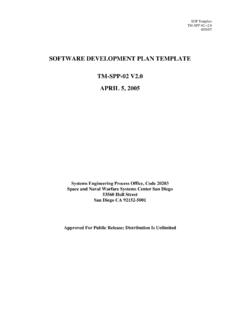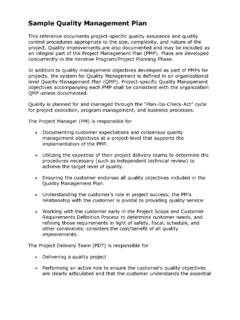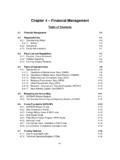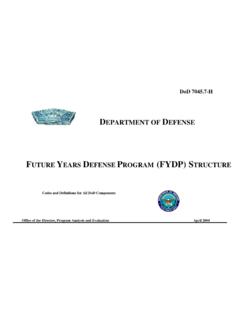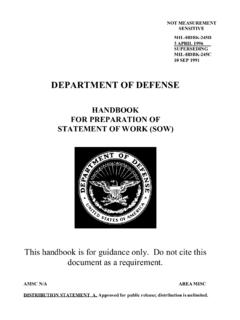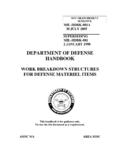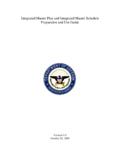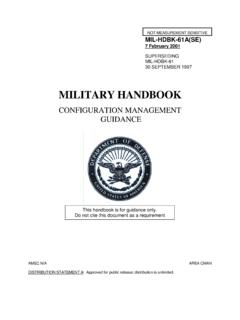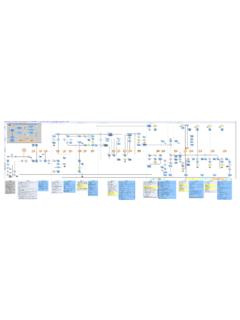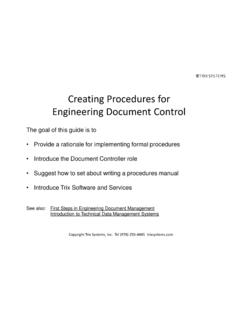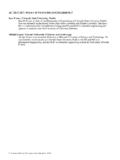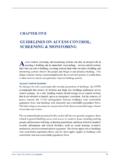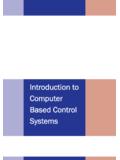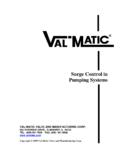Transcription of Systems Engineering Standards: A Summary - …
1 SYS 202 V4 standards Raw Artifact v Systems Engineering standards : A Summary Systems Engineering standards and Models Several Systems Engineering process standards and models exist that describe so-called Systems Engineering processes as well as best practices in accomplishing Systems Engineering . Past and current process standards and models include: MIL-STD-499 Series ANSI/EIA 632 IEEE 1220 ISO/IEC 15288 CMMI MIL-STD 499 Series. These military standards had a profound impact on the early development of Systems Engineering and standardization of its processes. The series started in 1969 when the US Air Force published MIL-STD-499 which was updated and republished in 1974 as MIL-STD-499A. Entitled Engineering Management , the stated objective of it was ..to assist Government and contractor personnel in defining the Systems Engineering effort in support of defense programs. The Systems Engineering process model included: (1) Mission Requirements Analysis; (2) Functional Analysis; (3) Allocation and (4) Synthesis.
2 See Figure 1. Figure 1: Example of a Systems Engineering Process Model SYS 202 V4 standards Raw Artifact v MIL-STD 499A was expanded and updated as the draft MIL-STD-499B ( Systems Engineering ). However, it was never formally published. As part of the 1990 s Acquisition Reform movement which cancelled or replaced nearly all DoD-unique military specifications, MIL-STD-499B was withdrawn. An interim industry standard (EIA/IS-632), which was a commercialized version of the May 1994 version of MIL-STD-499B was published in December 1994. ANSI/EIA 632. This standard originally published as an interim standard (IS) in 19941 which closely mirrored MIL-STD-499B, was significantly revised, made more abstract and general and re-published in January 1999. Titled Processes for Engineering a system , EIA 632 s stated purpose is: ..provide an integrated set of fundamental processes to aid a developer in the Engineering or re- Engineering of a system .
3 EIA 632 limits the set of required processes to those directly related to the technical aspects of Engineering Systems (13 processes included) and provides 33 requirements associated with completing the processes. It defines representative tasks and the expected outcomes associated with each one. There is not one process but a series of processes, in groups, with loops among them. See Figure 2. 1 Many definitions of Systems Engineering exist. The DoD s definition, as specified in the Defense Acquisition Guidebook, is derived partially from EIA/IS 632. That defines Systems Engineering as: An interdisciplinary approach encompassing the entire technical effort to evolve and verify an integrated and total life-cycle balanced set of system , people, and process solutions that satisfy customer needs . ANSI/EIA 632 ANSI/EIA 632 Process ModelProcess ModelAcquisitionProcessSupplyProcessAcqu isition& SupplyTechnical EvaluationSystemsAnalysisProcessSystemVe rificationProcessRequirementsValidationP rocessEnd ProductsValidationProcessTechnical ManagementPlanningProcessAssessmentProce ssControlProcessSystemDesignRequirements Definition ProcessSolution Definition ProcessProductRealizationImplementationP rocessTransition to UseProcessPlans,Directives& StatusOutcomes&FeedbackRequirementsDesig nsProductsAcquisitionRequestSystemProduc tsFigure 2: ANSI/EIA 632 Process Model SYS 202 V4 standards Raw Artifact v One key concept in EIA 632 is that of a system model oriented around Building Blocks.
4 Each Building Block is a system in itself, and thus consists of the End Products (which are defined by a customer need and perform the operational functions required by a customer), plus products and processes called Enabling Products that are necessary to develop, realize, test, deploy, utilize, support, and retire those products. IEEE 1220. This standard, entitled Application and Management of the Systems Engineering provides the next-level-of-detail description of the Systems Engineering processes defined in EIA 632. IEEE 1220 was originally published in 1995 as a trial-use standard; based on experience with the standard it was revised and published as a full standard in 1998. The stated purpose of IEEE 1220 is ..to provide a standard for managing a system from initial concept through development, operations and disposal . IEEE 1220 defines a Systems Engineering Process as a generic problem-solving process, which provides the mechanisms for identifying and evolving the product and process definitions of a system .
5 The Systems Engineering Lifecycle Model consists of: (1) system definition; (2) Subsystem definition ( , preliminary design, detailed design, fabrication/assembly/integration and test); and (3) Production and customer support. The Systems Engineering Process model outlined in IEEE 1220 conceptually is very similar to that of Figure 1 and includes: (1) Requirements Analysis; (2) Requirements Validation; (3) Functional Analysis; (4) Functional Verification; (5) Synthesis; and (6) Physical Verification. These processes are linked together via Control Processes consisting of Data Management; Configuration Management; Interface Management; Risk Management and Performance-based Progress Measurements. See Figure 3. IEEE 1220 Process ModelIEEE 1220 Process ModelRequirementsAnalysisRequirementsBas elineValidationFunctionalAnalysisSynthes isFunctionalVerificationPhysicalVerifica tionSystemsRequirement &ConstraintConflictsDecomposition &Requirement AllocationAlternativesDesign SolutionRequirements &AlternativesRequirements BaselineRequirementsTrade Studies &AssessmentsFunctionalTrade Studies &AssessmentsRequirementTrade-offs & ImpactsDecomposition/AllocationTrade-off s & ImpactsDesign SolutionTrade-offs & ImpactsValidated Requirements BaselineFunctional ArchitectureVerified Functional ArchitecturePhysical ArchitectureVerified Physical ArchitectureDesignTrade Studies &AssessmentsControlAnalysisPROCESS OUTPUTSPROCESS INPUTSF igure3:IEEE 1220 Systems Engineering ProcessSYS 202 V4 standards Raw Artifact v ISO/IEC 15288: 20022.
6 This standard, now retired, entitled Systems Engineering -- system Life Cycle Processes , has an extremely broad scope. It applies ..to the full life cycle of Systems , including conception, development, production, utilization, support and retirements of system and to [their] acquisition and supply. The processes specified in ISO/IEC 15288 cover the entire acquisition, program management and technical development gamut and establish a common framework from describing the lifecycle of Systems created by humans. See Figure 4. Systems , similar to EIA 632, are conceived to consist of two parts: (1) the system -of-interest (in EIA 632, the End Product) that provides desired capabilities and services and (2) Enabling Systems (EIA 632 uses the same terminology) that provide required services in each system lifecycle stage to include concept, development, production, utilization, support and retirement. Life cycle processes as specified in ISO/IEC 15288 include: Agreement Processes: covering acquisition and supply of Systems Enterprise Processes: describing resources and infrastructure necessary to support projects and ensure satisfaction of organizational objectives.
7 2 Note: ISO 15288:2002 was replaced by ISO 15288:2008 that was published in January 2008. A Summary of ISO 15288:2008 is provided in the next paragraph. However, because during this transition period, uses of both standards may be encountered in practice, the ISO 15288:2002 discussion is still retained in this document for reference purposes. Used to managetechnical processesUsed to establish requirementsUsed to create, support and monitor projectsEnterpriseProcessesProjectProces sesAgreementProcessesUsed to create products and services of life cycle stage that meet requirementsSystem-of-interestLife cycle stages(s1, s2, .. ,sn)Used to manage life cycle stagesUsed to arrive at and satisfy an agreementUsed to assess quality and progressDeliverable that satisfies agreementOutcomes used to assess progressTechnicalProcessesUsed to managetechnical processesUsed to establish requirementsUsed to create, support and monitor projectsEnterpriseProcessesProjectProces sesAgreementProcessesUsed to create products and services of life cycle stage that meet requirementsSystem-of-interestLife cycle stages(s1, s2.)
8 ,sn)Used to manage life cycle stagesUsed to arrive at and satisfy an agreementUsed to assess quality and progressDeliverable that satisfies agreementOutcomes used to assess progressTechnicalProcessesISO/IEC 15288 Role of ProcessesFigure 4: The Role of Processes in ISO/IEC 15288:2002 SYS 202 V4 standards Raw Artifact v Project Processes: which are used to establish and evolve project plans; to assess actual achievement and to control project execution. These include such processes as Decision-Making, Risk Management, Configuration management, Information/Data Management and Assessment. Technical Processes: these are those used to define requirements; to transform them into an effective product; to reproduce/produce the product; to effectively use, sustain and dispose of the product. Each of these processes are further broken down into subsidiary processes. They are illustrated in Figure 5 below. The DoD s eight system Engineering Technical Processes3 are a subset of the Technical Processes derived from ISO 15288:2002.
9 3 These processes are: Stakeholder Requirements Definition, Requirements Analysis, Architectural Design, Implementation, Integration, Verification, Validation and Transition. ISO/IEC 15288 Process ModelISO/IEC 15288 Process ModelFigure 5: ISO/IEC 15288:2002 Process Details SYS 202 V4 standards Raw Artifact v ISO/IEC 15288:2008 This standard, entitled Systems Engineering -- system Life Cycle Processes , replaced ISO 15288:2002 in January 2008. Like its predecessor, it has an extremely broad scope. It ..establishes a common process framework for describing the life cycle of man-made [describing] a set of processes and associated terminology for the full life cycle including conception, development, production, utilization, support and retirement and also supports the definition, control assessment and improvement of these processes . Systems Engineering standards and software development standards historically have not been well aligned.
10 Different process names and procedures were used, making the interface between software and system development confusing at best. One of the goals in development of ISO/IEC 15288:2008 was to initiate a harmonization effort between it and the corresponding ISO/IEC 12207:2008 ( Systems Engineering --Software Life Cycle Processes) both at the international and national levels. To that end, the IEEE has adopted ISO/IEC 15288:2008 as a US national standard, numbering it as IEEE Std 15288 -2008. Additionally, the corresponding international software standard was updated as ISO/IEC 12207:2008, adopted by the IEEE and published as IEEE Std 12207 -2008. Many processes in ISO/IEC 15288: 2008 are similar to those in its 2002 predecessor, with some refinements to better align Systems and software development processes. See Fig 6 below. Figure 6 ISO 15288:2008 Process SetsSYS 202 V4 standards Raw Artifact v CMMI. The Capability Maturity Model, Integrated or CMMI refers to a product suite of development, acquisition and service processes models4 designed to be used for process improvement.
